
eBook - ePub
Oil Painter's Bible
An Essential Reference for the Practicing Artist
Marylin Scott
This is a test
Partager le livre
- 192 pages
- English
- ePUB (adapté aux mobiles)
- Disponible sur iOS et Android
eBook - ePub
Oil Painter's Bible
An Essential Reference for the Practicing Artist
Marylin Scott
Détails du livre
Aperçu du livre
Table des matières
Citations
À propos de ce livre
Learn how to use and enjoy one of the most satisfying painting mediums with this handy compact guide. Contains essential information on the materials, equipment, and techniques for creating accomplished works in oils. Step-by-step sequences show how to paint a range of themes, from still life to portraits and landscapes, with advice on more difficult subjects. Includes suggestions for presenting your finished paintings and how to go about getting your work seen and exhibited.
Foire aux questions
Comment puis-je résilier mon abonnement ?
Il vous suffit de vous rendre dans la section compte dans paramètres et de cliquer sur « Résilier l’abonnement ». C’est aussi simple que cela ! Une fois que vous aurez résilié votre abonnement, il restera actif pour le reste de la période pour laquelle vous avez payé. Découvrez-en plus ici.
Puis-je / comment puis-je télécharger des livres ?
Pour le moment, tous nos livres en format ePub adaptés aux mobiles peuvent être téléchargés via l’application. La plupart de nos PDF sont également disponibles en téléchargement et les autres seront téléchargeables très prochainement. Découvrez-en plus ici.
Quelle est la différence entre les formules tarifaires ?
Les deux abonnements vous donnent un accès complet à la bibliothèque et à toutes les fonctionnalités de Perlego. Les seules différences sont les tarifs ainsi que la période d’abonnement : avec l’abonnement annuel, vous économiserez environ 30 % par rapport à 12 mois d’abonnement mensuel.
Qu’est-ce que Perlego ?
Nous sommes un service d’abonnement à des ouvrages universitaires en ligne, où vous pouvez accéder à toute une bibliothèque pour un prix inférieur à celui d’un seul livre par mois. Avec plus d’un million de livres sur plus de 1 000 sujets, nous avons ce qu’il vous faut ! Découvrez-en plus ici.
Prenez-vous en charge la synthèse vocale ?
Recherchez le symbole Écouter sur votre prochain livre pour voir si vous pouvez l’écouter. L’outil Écouter lit le texte à haute voix pour vous, en surlignant le passage qui est en cours de lecture. Vous pouvez le mettre sur pause, l’accélérer ou le ralentir. Découvrez-en plus ici.
Est-ce que Oil Painter's Bible est un PDF/ePUB en ligne ?
Oui, vous pouvez accéder à Oil Painter's Bible par Marylin Scott en format PDF et/ou ePUB ainsi qu’à d’autres livres populaires dans Art et Art Techniques. Nous disposons de plus d’un million d’ouvrages à découvrir dans notre catalogue.
Informations
Sujet
ArtSous-sujet
Art Techniques
Fat over lean
Paint which has a high percentage of oil is described as “fat.” “Lean” paint is that which has been thinned with turpentine or mineral spirit only. The golden rule in oil painting is to paint fat over lean, and there are good reasons for this. The drying oils used both in the manufacture of paint and as a medium do not evaporate. They simply dry and harden on exposure to air, but this takes a long time (six months to a year to become completely dry). During this process the paint surface shrinks a little. If lean paint has been applied over oily paint the top layer will dry before the lower one has finished shrinking, and this can cause the hardened lean paint to crack and even flake off.
So, for any painting built up in layers the oil content should progressively increase. The usual practice is to begin with turpentine alone, or turpentine with just a little oil added, and add more oil to the mixture as the painting progresses. The final layer can be as thick as you like, and this is when artists sometimes add highlights in impasto (see page 88).

The blue paint on the left is lean, as it has been well diluted with turpentine. The red paint, straight from the tube, has a much more substantial texture.

1 Some preliminary underpainting in thin, lean paint provides a basis for the application of subsequent layers of oilier paint.

2 The image is built up using slightly thicker paint, but this is less oily than that which will be used later.
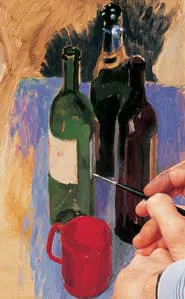
3 Apart from the danger of paint cracking as it dries, another reason for painting fat over lean is that it is difficult to add lean paint to a very oily layer. It does not adhere properly, so your brush tends to lift if off again.
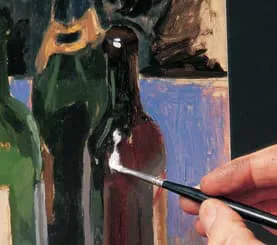
4 Fat white paint straight from the tube is applied for the highlights. This must be done last, as it would be impossible to paint further over these oil-rich patches with the paint still wet.
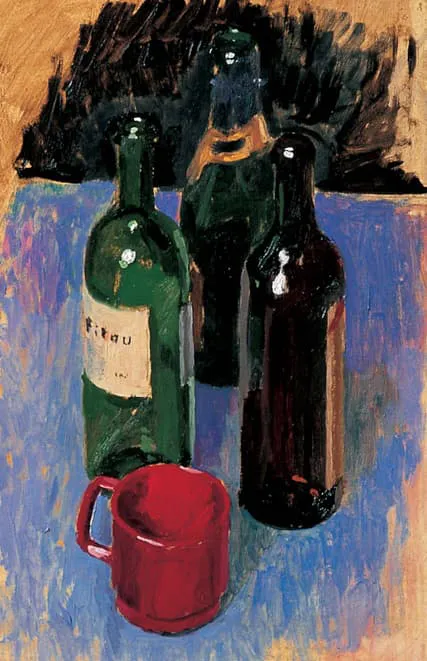
5 The completed painting shows a mixture of different paint thicknesses. The blue tabletop consists of quite lean paint while parts of the bottles have been built up with increasingly oily paint.
Alla prima
This is an Italian term meaning “at first,” and it describes paintings completed in one session. The essential characteristic of this method is that there is no initial underpainting as such (see page 112), although artists will often make a rapid underdrawing in pencil or charcoal to establish the main lines.
After the introduction of tubed paint in the mid-19th century, artists were able to work outdoors more easily. This plein air (open air) painting, as it is called, first undertaken by painters such as Constable, Corot and later the Impressionists, established the rapid and direct approach as an acceptable technique. Hitherto, oil painting had been largely a studio activity, as pigment had to be ground by hand, and paintings were built up slowly in a series of layers.
Working alla prima requires some confidence, as each patch of color is laid down more or less as it will appear in the finished picture. Any modifications and reworking must be kept to a minimum so that the fresh effect is not destroyed.

1 Because it is difficult to get ellipses right, these were first drawn with pencil. The next stage was to block in some of the shaded areas with cobalt blue and the tablecloth with ocher, which helped to establish the feel of the composition. This photograph shows some of the basic colors being laid in with somewhat thicker paint. The colors are those that will appear in the finished painting, though minor modifications can be made as the work progresses.
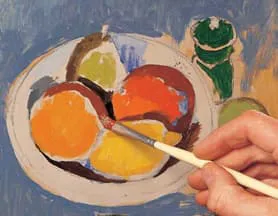
2 The tablecloth has been loosely painted, and now the darker tones of the fruit are developed. The bold brushstrokes give a three-dimensional appearance.
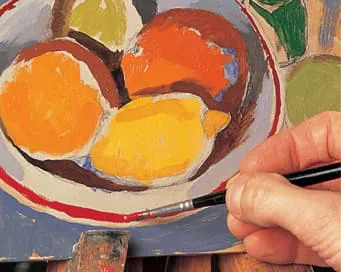
3 The red stripe around the bowl is crucial to the composition, so it is painted next, in a mixture of cad...